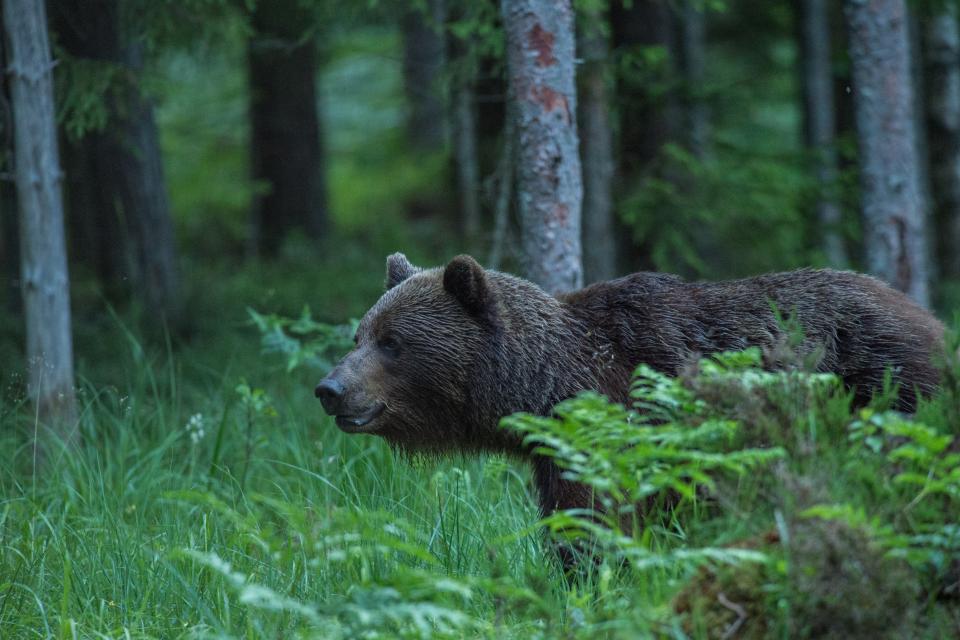The bear – as if aware of his role as the leading act of the night, seemed relaxed and happy; he just kept wandering around, wading in the stream, scratching his back against the tree-stems, disappearing in the woods and returning to the clearing on either side of the hut throughout the evening. He didn’t take notice of any human observers while the raccoon-dogs respectfully kept their distance, only appearing when the bear was busy elsewhere. The bright Estonian midsummer night allowed great views of the animals until well after midnight.
Bert Rähni’s company NaTourEst has been offering adventure and nature holidays in Estonia since 2008 and now owns 85 ha of wilderness, approximately 150 km east of Tallinn Tallinn, the largest city and capital of Estonia (population 440 000). . It’s located at the western end of the Alutaguse region where about half of Estonia’s 800 brown bears live. Once arriving at the meeting point, there is a bear nature trail to learn about the habits of brown bears, recognize signs of them in the surroundings, and also dismiss myths – like bears sleeping in caves!
In Estonia, they actually mostly make a ‘nest’ under a thick fir tree during the months of hibernation. The number of bears and the frequency of twin and triplet cubs is a sign that the population is healthy and doing well. When people spot a mother bear with more cubs of different ages, it may well be that she has also ‘adopted’ a young one from the previous season. Female bears are compassionate and sharing. It’s the young males who make trouble, “just as in most species”, comments Rähni.
In spite of the size of the population, bear attacks are extremely rare in Estonia and there is no record of a person being killed by a bear.
After the ‘bear basics’, a guide takes the guests to the hut. It’s a hike of 2 km through the woods, a great last chance to stretch the legs before staying inside until the next morning.
The two huts – the only bear-watching facilities in the Estonian wilderness – have space for 9 people each, and cater to groups as well as individual nature lovers. The huts have windows in two directions, chairs, bunk beds and a toilet. There’s no plumbing and no electricity but, of course, there is WiFi! Rähni developed the huts in a way that they would offer basic comfort and avoid disturbing the animals with light, noise and smells. One lovely feature is a sound system that brings outdoor sounds into the hut, so the guests feel truly immersed in wilderness, yet completely safe.
As the Coronavirus shut down international tourism during the most popular animal-watching season, local Estonians are starting to discover it. Until now, nature adventurers from Germany, Switzerland, Netherlands, the UK and Austria have made up the majority of clients for NaTourEst. They were the first company to receive a group of nature tourists from Germany in May, just after the travel restrictions were lifted.
Their services include all-round nature adventures, from kayaking trips to islets around Hiiumaa Second largest island in the NW of Estonia(pop.10,000). , to bog-walks, birdwatching, cycling tours etc. 2020 has hit the tourism industry hard worldwide. It seems, that nature travel might be a safe option during the pandemic – spending time in fresh air, with no crowds other than wild animals.
Still, travelling to Estonia by airplane or ferry is the least safe part of the journey according to clients of NaTourEst. Therefore, Rähni has noticed an unusual upsurge of people travelling to Estonia all the way from Germany or the Netherlands by car. For the company, it’s been an extraordinary summer, as Rähni comments: “Foreign tourists have started to return slowly but there are more and more Estonians. April and May gave us a big blow and now we hope that the virus doesn’t flare up again. Right now, we have to administer an incredible amount of cancellations and new bookings at the same time.”
But, back to the bear hide-out.
There is no guarantee for bears to visit the spot each and every night. In order to avoid the animals getting used to humans and dependent on feeding there is no bait apart from a few smells and small pieces of fish or a handful of grain: just enough to make them curious. So, luck is part of the authentic experience.
It is also a surprisingly calming experience. At first, it felt as though you had to be quick to see the animals, but after a little while a slow-down mode settles over the observers. You wait quietly and when you see an animal, there is no hurry – they don’t run off scared. They are not being chased and just mind their own business quietly. We were lucky to already see the bear early in the evening and extensively. Nevertheless, you won’t feel like leaving the hut in the middle of the forest with a young male bear in the vicinity. The rule is – you leave the hide-out at 8 am. So, when the dusk finally settles over the clearing, it’s time to slumber in your sleeping bag to the lullaby of the birds.
More information at natourest.ee.



